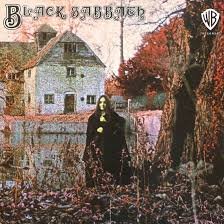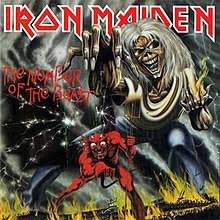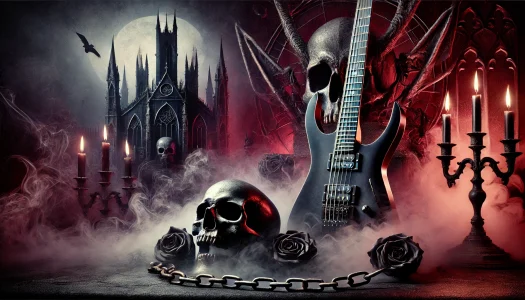The worlds of horror and metal share a natural kinship, both rooted in exploring humanity’s darkest fears and confronting taboos. From the eerie, detuned riffs of Black Sabbath to the visceral intensity of extreme metal subgenres, metal music has long drawn on horror’s unsettling allure. Both art forms tap into a primal urge to face fear head-on, whether through graphic imagery, supernatural themes, or the raw portrayal of psychological dread. This overlap isn’t simply aesthetic—metal and horror are united by a common mission to defy the norms of “safe” expression, pushing boundaries to provoke, disturb, and, ultimately, reveal hard truths about the human psyche.
Historical Origins of Horror in Metal

The roots of horror in metal trace back to some of the most iconic works of horror literature and classic cinema, with early metal bands drawing on these dark sources to shape the genre’s identity. Gothic literature by authors like Edgar Allan Poe, who delved into themes of madness and death, and H.P. Lovecraft, who introduced audiences to cosmic horrors beyond human comprehension, left a lasting imprint on metal’s narrative style and lyrical themes. These writers’ explorations of fear, the supernatural, and existential dread resonated with the emerging countercultural spirit of metal, fueling a fascination with the shadowy aspects of human experience.
Classic horror films also played a key role in inspiring metal’s foundational acts. Early horror cinema, especially the black-and-white Universal monster movies featuring figures like Dracula, Frankenstein, and the Wolfman, captivated audiences by blending suspense, dark aesthetics, and moral ambiguity. As metal developed, the genre embraced these motifs, finding in horror cinema both a visual style and thematic inspiration for songs and stagecraft that would captivate audiences in much the same way.
Convergence of Horror and Metal
This convergence of horror and metal found its first major expression in the work of early pioneers like Black Sabbath, whose very name and sound heralded a new, ominous direction in rock music. Their self-titled debut album in 1970 opened with the eerie tolling of a church bell, setting the stage for dark, slow, and heavy riffs that contrasted starkly with the rock and roll of the time.
Drawing from horror’s aesthetics, Sabbath’s lyrics explored themes of war, occultism, and fear, invoking a sense of dread that resonated deeply with listeners. This fascination with the macabre established Black Sabbath as a band that would define the genre, opening the floodgates for future metal acts to expand on horror’s influence and make it a lasting element of metal music.
Thematic Overlaps Between Horror and Metal
Metal music and horror are bound by their willingness to confront unsettling themes, making death, violence, the supernatural, and psychological darkness recurring motifs across both. Metal often serves as an auditory vessel for these themes, using heavy soundscapes and powerful lyrics to explore the depths of fear and fascination with the unknown.
Death and Mortality
Metal music, like horror, frequently delves into themes of death, the afterlife, and existential dread. Songs across subgenres, from traditional heavy metal to doom metal, approach mortality as both a mystery and a form of catharsis, allowing listeners to face the ultimate unknown in a controlled, artistic space. Lyrics about death and what lies beyond often carry existential weight, contemplating life’s impermanence or depicting vivid journeys into the afterlife. For instance, doom metal bands like Candlemass craft somber reflections on mortality, drawing listeners into haunting atmospheres that echo the inevitability of death. Through exploring these themes, metal mirrors horror’s use of mortality as a tool to probe human vulnerability and confront society’s ultimate taboo.
Violence and Gore
Horror’s fascination with visceral imagery finds a natural home in extreme metal subgenres, especially death metal and grindcore, where violence and gore take center stage. In these genres, graphic depictions of blood, suffering, and destruction serve as metaphors for inner and societal turmoil. Lyrics are often as confrontational as the growling vocals and frenetic guitar work that accompany them, pulling listeners into scenes of carnage that echo the exaggerated horror of films like Hellraiser or The Texas Chainsaw Massacre.
Bands like Cannibal Corpse and Carcass use these graphic themes as a form of release and transgression, pushing boundaries to evoke discomfort and challenge societal norms around violence and death. In this way, metal’s fascination with gore is both a tribute to horror and a means of artistic rebellion.
Occult and Supernatural Themes
Horror’s engagement with the occult and supernatural is also deeply embedded in metal, particularly in black and heavy metal, which are rich with references to demons, spirits, and mythological figures. This fascination with dark spirituality and forbidden knowledge reflects metal’s longstanding rejection of mainstream values and exploration of the mysterious. Bands like Mercyful Fate and Ghost infuse their music with occult themes, using dark rituals, satanic imagery, and mythological narratives to evoke a sense of otherworldly power and awe. By drawing on horror’s occult motifs, metal positions itself as an art form that doesn’t shy away from themes that might be taboo, delving into spirituality, mysticism, and the paranormal with unflinching intensity.
Psychological Horror
Psychological horror—focused on the exploration of inner fear, mental anguish, and existential anxiety—finds expression in metal subgenres like doom and black metal, which channel introspective darkness and emotional depth. Doom metal’s slow, haunting soundscapes echo the weight of despair and introspection, while black metal’s raw, atmospheric sound creates a chilling sense of isolation and nihilism. Bands like My Dying Bride and Neurosis use lyrics that explore despair, fear of insanity, and spiritual decay, resonating with psychological horror’s focus on the internal over the external. This introspective quality gives metal an added layer of complexity, portraying horror not just as a spectacle but as an inward journey, where the mind itself becomes a terrifying landscape.
Iconography and Aesthetic Influences

The visual identity of metal owes much to horror’s signature aesthetics, with gothic imagery, eerie stage setups, and cinematic elements often at the forefront of the genre’s presentation. Metal musicians use these visual themes to build an immersive experience that complements their dark soundscapes and lyrical content, blurring the line between music and horror theater.
Album Art and Stage Presence
Metal’s visual appeal is rooted in horror-inspired iconography that’s instantly recognizable. Album covers across nearly every subgenre draw heavily on gothic and macabre aesthetics, often featuring dark castles, decaying landscapes, skulls, and ominous symbols. Bands like Iron Maiden have made horror-centric art an integral part of their identity, with their mascot, Eddie, transforming with each album to reflect gory, supernatural, or dystopian themes. Similarly, death and black metal bands use album covers featuring nightmarish scenes, from desolate graveyards to disturbing scenes of the occult, invoking a sense of dread before a single note is played.
On stage, metal musicians amplify this connection to horror through theatrical costumes, corpse paint, and ritualistic props. Black metal acts like Mayhem and Gorgoroth are known for their dark, blood-splattered performances, often adorned in armor, leather, and corpse paint that evokes both horror films and ancient funerary rites. These elements of stagecraft aren’t just for shock value—they create an atmosphere that mirrors horror’s ability to envelop audiences in a different reality, transporting them to a world where darkness reigns.
Use of Cinematic Horror Elements
Many metal bands also draw directly from cinematic horror, incorporating film-inspired visuals into music videos, live performances, and concept albums. Artists like Rob Zombie and King Diamond have become iconic for their integration of horror’s cinematic language. Rob Zombie, who also directs horror films, seamlessly blends his music with horror movie visuals, using scenes of graveyards, monsters, and unsettling close-ups to enhance his songs’ themes. His stage shows further heighten the horror with elaborate props, moving sets, and lighting effects that give audiences a full theatrical experience.
King Diamond, known for his concept albums, builds entire narratives around horror tropes, using costumes, props, and set designs to create a cohesive story that feels like watching a horror movie in real time. His albums, such as Abigail and Them, are structured with plotlines that could be straight from a horror screenplay, complete with supernatural hauntings and twisted family secrets. Meanwhile, black metal bands like Watain take horror’s influence further by incorporating blood rituals and fire into their performances, creating an atmosphere reminiscent of classic occult horror films.
The Role of Sound in Evoking Horror
The connection between horror and metal isn’t limited to themes and imagery; it’s deeply embedded in the sound itself. Through deliberate choices in instrumentation, production, vocal styles, and compositional techniques, metal musicians create atmospheres that mirror the tension and fear typically evoked by horror films. This auditory approach not only underscores the genre’s darker themes but also engages listeners on a visceral level, making the experience of listening to metal akin to stepping into a horror story.
Instrumentation and Production Techniques
Metal musicians often employ dissonant chords, minor keys, and unconventional time signatures to build an unsettling atmosphere. Dissonance, in particular, disrupts the ear’s expectation for harmony, creating a feeling of unease that mirrors the psychological effect of suspense in horror movies. Bands like Slayer and Opeth use this dissonance alongside minor scales to inject a sense of foreboding, enhancing the themes of death and despair in their music. The use of tritone intervals—historically referred to as “the Devil’s interval” for its dark tonal quality—has been a staple in creating a haunting, ominous feel in metal, echoing the eerie tones found in classic horror soundtracks.
In addition, production techniques such as heavy reverb, slow tempos, and low-frequency rumbling simulate the sonic qualities of horror, amplifying a track’s intensity. Doom metal bands like Electric Wizard and Sunn O))) employ dense, distorted soundscapes that feel immersive and claustrophobic, mimicking the slow-burn tension of a horror film. These elements, combined with dynamic shifts that build anticipation, create music that feels suspenseful and intense, inviting listeners to brace themselves for what’s to come.
Vocal Styles
Vocal techniques in metal further enhance the genre’s horror-like atmosphere. Guttural growls, piercing screams, and high-pitched shrieks evoke primal fear, mirroring the kind of vocalizations associated with terror in horror. Death metal pioneers like Cannibal Corpse use low, guttural growling to create a sense of menace, while black metal bands such as Immortal and Burzum favor high-pitched screams that sound tortured and ghostly. These vocal styles defy the natural speaking voice, adding to the music’s otherworldly quality and amplifying the themes of horror and monstrosity.
Moreover, vocalists use distortion and reverb to create a “detached” effect, making their voices feel as though they’re coming from a sinister character rather than the performer. This approach aligns with the horror genre’s use of voices to represent non-human entities or inner demons, bringing an additional layer of immersion and dread to metal performances.
Influence of Horror Soundtracks
The influence of horror soundtracks on metal is significant, with many metal musicians drawing inspiration from film composers like John Carpenter, Goblin, and Bernard Herrmann. Horror soundtracks often rely on minimalism, eerie synth lines, and sustained chords to create tension, and metal artists have adopted these techniques to craft similarly haunting atmospheres. For instance, Italian band Goblin, known for their work on Suspiria, inspired acts like Rob Zombie and Sunn O))), who incorporate haunting synthesizers and ambient soundscapes reminiscent of classic horror scores.
John Carpenter’s distinctive use of synths and repetitive bass lines to create a sense of impending dread has also permeated metal, especially in darker subgenres. Bands like Carpathian Forest and even modern metalcore groups incorporate synth-driven intros and interludes that evoke Carpenter’s minimalistic suspense, adding layers of unease to their music. The crossover between horror film scores and metal music has led to a shared sonic vocabulary that’s become a hallmark in both genres—cold, atmospheric, and always on the edge of darkness.
Why Horror Resonates with Metal Audiences
Horror themes and metal music connect deeply with fans, offering not just entertainment but an outlet for emotions and perspectives that are often marginalized or taboo. Horror and metal create a space where fear, rebellion, and societal critique are welcome, allowing listeners to explore complex feelings and concepts in a setting that feels both liberating and intense.
Psychological Catharsis
For many fans, the horror themes in metal serve as a powerful source of psychological catharsis. By immersing themselves in lyrics and soundscapes that confront death, fear, and darkness, listeners can face these otherwise overwhelming concepts in a safe, controlled setting. This cathartic release mirrors the experience of watching a horror film, where facing terrifying situations from the safety of the audience allows for an emotional purge without real-world consequences.
Metal’s raw, aggressive energy channels intense emotions, enabling listeners to confront their own fears, anger, or frustration indirectly. In dealing with themes that might otherwise be repressed—like mortality, existential dread, or even societal disillusionment—fans often describe the experience of listening to metal as cleansing, leaving them with a sense of calm or release. By tapping into horror’s focus on human vulnerability and fear, metal music offers a therapeutic outlet that validates difficult emotions and encourages introspection, resonating with listeners who find strength and solidarity in its darkest themes.
Anti-Establishment and Counter-Culture Appeal
Horror and metal share a natural affinity for counter-culture, both operating outside the mainstream and challenging societal norms. In metal, horror’s defiance of “safe” storytelling becomes a powerful form of rebellion. Both genres often address themes that society typically avoids, from graphic depictions of violence and the occult to existential questions that push against traditional beliefs. This stance appeals strongly to listeners who feel disillusioned with conventional culture, as metal and horror together become an avenue to reject conformity and explore life’s harsh realities on their own terms.
The anti-establishment spirit of metal resonates especially with fans who feel marginalized or at odds with mainstream values. Metal’s rejection of polished, sanitized content mirrors horror’s embrace of the raw and unsettling, making it a refuge for those seeking something honest, gritty, and unafraid to provoke. Whether through lyrics critiquing political corruption, songs addressing psychological trauma, or performances designed to shock, metal embodies a rejection of societal limitations, reinforcing the genre’s connection to horror as a space for questioning authority and exploring the unknown.
Closing Thoughts
Horror has profoundly shaped the evolution of metal, weaving its themes, aesthetics, and atmospheres into the very fabric of the genre. From the earliest days of Black Sabbath’s ominous riffs and lyrics to the visceral extremes of death metal, horror’s influence has driven metal to explore themes of fear, mortality, rebellion, and the supernatural with unflinching intensity. By drawing on horror’s dark narrative techniques and visual cues, metal has created a unique space where fans can confront their deepest anxieties and experience a kind of catharsis that transcends entertainment.
The ongoing appeal of horror themes in modern metal speaks to the timelessness of these dark explorations. Even as the genre expands and evolves, bands continue to use horror-inspired sounds and images to address both personal and societal fears. Metal’s embrace of horror themes remains relevant, offering listeners a powerful means of self-expression and a mirror to confront a world that is often complex and challenging. In combining horror’s thrill with metal’s intensity, the genre ensures that its exploration of the macabre and mysterious will continue to resonate for generations to come, keeping its fans on the edge of discovery and defiance.
